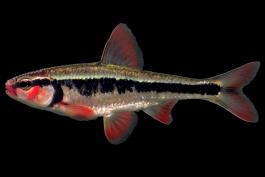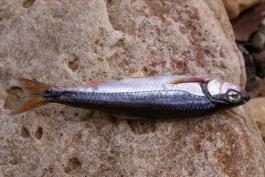
The bleeding shiner has an olive-brown back and a broad dark stripe along the midline. Sides are silvery with two black stripes separated by an iridescent golden stripe: A prominent black stripe extends to the tip of the snout, paralleled above by a narrow and sometimes indistinct secondary stripe. The stripe along the midline of the back is very dark and broader than the base of the dorsal fin. Gill opening has a prominent, crescent-shaped, dark bar. Belly is silvery white.
Like several other shiners found in clear Ozark streams, male bleeding shiners sport brilliant red during breeding season, especially May and early June. Breeding males have darker markings, and parts of the head, body, and fins are bright red. Breeding tubercles are largest on the head but are also present on foreparts of body and some fins.
Similar species: The cardinal and duskystripe shiners are similar, but the bleeding shiner has the dark bar along the rear edge of the gill opening, and the dark stripe along the midside is abruptly narrowed just behind the gill opening and does not touch the lateral line beneath the dorsal fin (except in breeding males).
Total length: 3 1/2 to 4 1/2 inches; maximum about 4 3/4 inches.

Restricted to the Ozark Uplands of Missouri and northeastern Arkansas. Occurs in all major drainages not occupied by the closely related cardinal shiner and duskystripe shiner.
Habitat and Conservation
Occurs in schools in midwater, often in association with the striped, telescope, rosyface, and wedgespot shiners. This minnow inhabits clear, small creeks to moderately large rivers having persistent strong flow. It typically is found over a clean, gravelly or rocky bottom, near riffles or in pools with noticeable current. The young tend to occupy quieter water than the adults.
Food
The large eyes of this minnow suggest that it feeds primarily by sight. It feeds to a considerable extent on insects and other small invertebrates found floating on the water's surface or drifting with the current.
Life Cycle
Spawning occurs in our state from late April to early July, especially in May and early June. Most often, spawning is over the gravel nests and pits made by other fish. Breeding bleeding shiners gather over these sites in groups of a few to a hundred or more individuals. Few individuals live beyond three summers.




























